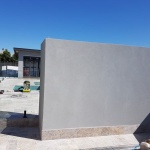What type of render should I use? Cement or acrylic?
If you are looking to add some much needed protection to your walls, or if you want to attain a certain aesthetic for your house, you may be wondering what type of rendering material and formula might be best for you: cement or acrylic.
Within this article, our team here at Zaks render aim to provide you with some support so you can make an informed decision as to what is right for you!
So What Is Cement Rendering?
Cement render is essentially a thick layer of different mixed composite materials that is applied over the substructure of a wall. It is comprised of premixed sand and cement, which can be smoothed out with a sponge finish to improve the aesthetic quality of your house.
Cement rendering consists of a base coat and a top coat. The textural quality of the base coat is usually rather course and abrasive. This is resolved by the application of the top coat layer as it provides a more consistent and smooth finish to the exterior walls.
Buildings that are composed of brick, stone or mud benefit immeasurably form a layer of strongly constituted and well applied cement rendering. One massive benefit is that it fundamentally shields the building from decaying by covering the substructure, away from the elements.
However it is absolutely necessary that the exact formula of the cement rendering is compatible with the substructure of the building for it to work effectively. The lime that is present in the cement render formula enables effective bonding to the structure, making it crack resistant as it dries out. This is attributed to the antibacterial effect of the lime.

How Does It Compare To Acrylic Rendering?
Acrylic render is most commonly applied to brick or concrete walls and is formulated with a specialised acrylic substance. With walls that are built from masonry, it adds a coloured texture and preserves them. We personally like to use Dulux Acratex when applying acrylic rendering.
When factoring in the cost of labour, Acrylic rendering is the cheaper option. This is due to the acrylic rendering formula being easier to mix and apply. It also brings with it the added benefit of being extremely resistant to deterioration from harsh uv light. It is so effective at blocking out uv light that it can actually last over 20 years without fading!
And that’s not all; acrylic render also is resistant to cracking over time and is essentially waterproof. This makes it the ideal render when factoring into consideration its ability to protect the house from the elements.
Acrylic rending only needs a single application to be properly begin to bond to masonry. This is a huge benefit when compared to other forms of rendering. If added colour and protection is wanted, applying another coat is also absolutely achievable.
If you wish to increase the level of protection that it achieves, or add some more colours, you can simply apply an additional coat! The application of acrylic rendering is easy as it is a pre mixed formula, which could ultimately save you in labour costs.
Get in touch with Zaks Render for all of your rendering needs!
Working out what Rendering solution is best suited for your situation is difficult. We have developed our craft with years of experience with many different applications of cement and acrylic based renders.
If you would like to learn more about what rendering solution would work best for your needs, get in contact with us online now, or give us a call on 0402283119! We are always happy to help with your rendering projects!



